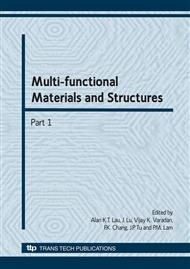p.1355
p.1359
p.1363
p.1367
p.1371
p.1375
p.1379
p.1383
p.1387
The Design of Novel Scaffolds by Integrating Microbial Cellulose onto Plasma Treated Polypropylene
Abstract:
The effect of plasma treatment on physicochemical properties of a porous polypropylene (PP) membrane was studied. The treated porous membranes were used as substrates for Acetobacter xylinum to grow and produce microbial cellulose pellicle. The effects of modifications on wettability and morphology were correlated with the growth rate of microbial cellulose. The CO2, O2 and N2/H2 plasmas modification not only can increase the hydrophilicity of the membrane but also enhance the growth of microbial cellulose. For 14 days of cultivation, the amount of microbial cellulose found on O2 treated substrate was approximately 2 folds of that on the untreated membranes.
Info:
Periodical:
Pages:
1371-1374
Citation:
Online since:
June 2008
Authors:
Price:
Сopyright:
© 2008 Trans Tech Publications Ltd. All Rights Reserved
Share:
Citation:


